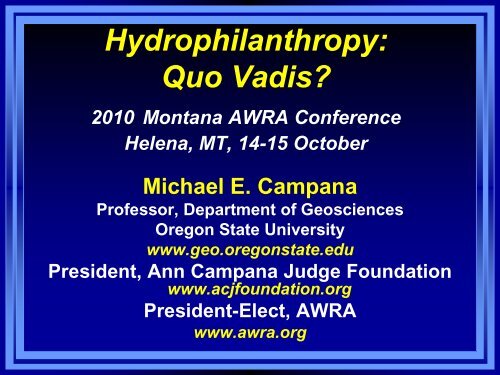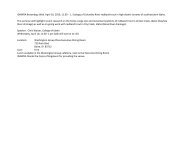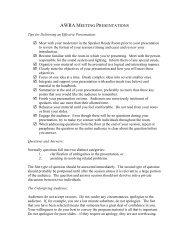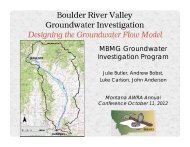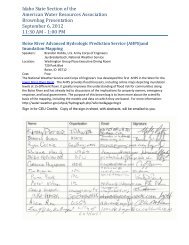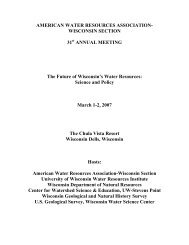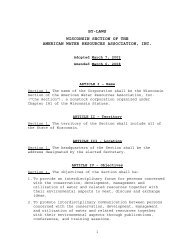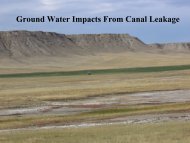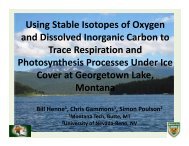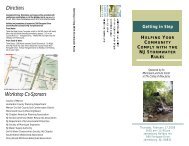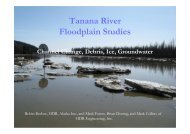Hydrophilanthropy: Quo Vadis?
Hydrophilanthropy: Quo Vadis?
Hydrophilanthropy: Quo Vadis?
You also want an ePaper? Increase the reach of your titles
YUMPU automatically turns print PDFs into web optimized ePapers that Google loves.
<strong>Hydrophilanthropy</strong>:<br />
<strong>Quo</strong> <strong>Vadis</strong>?<br />
2010 Montana AWRA Conference<br />
Helena, MT, 14-15 October<br />
Michael E. Campana<br />
Professor, Department of Geosciences<br />
Oregon State University<br />
www.geo.oregonstate.edu<br />
President, Ann Campana Judge Foundation<br />
www.acjfoundation.org<br />
President-Elect, AWRA<br />
www.awra.org
Talk Organization<br />
• My Background<br />
• Introduction<br />
• The Need<br />
• <strong>Hydrophilanthropy</strong> in Practice<br />
• Pitfalls, Mistakes, and Issues<br />
• The Future of <strong>Hydrophilanthropy</strong>
1) My Background<br />
• Born in Manhattan (NY, not KS). Grew up on Long<br />
Island, NY. Left East for good in 1970 (one year of<br />
penance in Atlanta in early 1980s)<br />
• Undergraduate degree in Geology – College of William<br />
& Mary (40 th reunion in a week!)<br />
• Learned my water (hydrology) at U. of Arizona –<br />
emphasis on groundwater<br />
• Spent virtually entire adult life (1970 – 2006) living and<br />
working (DRI and U of NM) in arid West (AZ, NV, CA,<br />
NM). Rehydration: western Oregon since 2006<br />
• International work: Central America, South Caucasus,<br />
Central Asia, Egypt, Europe<br />
• Favorite compliment (depending upon who says it):<br />
„You don‟t sound like an academic!”
Significant „Water‟ Events<br />
• 1975: Finished graduate work at U of AZ<br />
• Mid-1990s: went over to “dark side” - policy,<br />
management, etc. Hung out with economists,<br />
sociologists, lawyers, et al. Subsequently<br />
banned from many scientific meetings.<br />
• Late 1990s: Started focusing on WaSH (water,<br />
sanitation, and hygiene) issues in developing<br />
regions. Volunteer work with LI and LWI.<br />
• 2002: Founded 501(c)(3) - Ann Campana<br />
Judge Foundation (www.acjfoundation.org) –<br />
funds and undertakes water and sanitation<br />
projects in Central America<br />
• 2006: Social Media - Blogging and Tweeting
2) Introduction<br />
“Be ashamed to die until you<br />
have won some victory for<br />
humanity.” – Horace Mann
Purpose<br />
• Introduce the concept of<br />
<strong>Hydrophilanthropy</strong><br />
• The need for clean water and<br />
sanitation<br />
• Example of a hydrophilanthropic<br />
project<br />
• Mistakes, pitfalls, issues<br />
• Future
<strong>Hydrophilanthropy</strong> - 1<br />
Term coined by David Kreamer<br />
of UNLV around 2005.<br />
Never really defined it.<br />
[See DK‟s article „The Meaning of<br />
<strong>Hydrophilanthropy</strong>‟ in September<br />
2010 Water Resources IMPACT]
<strong>Hydrophilanthropy</strong> -2<br />
Definition: Altruistic concern<br />
for the water, sanitation, and<br />
related needs of humankind, as<br />
manifested by donations of<br />
work, money, or<br />
resources.
<strong>Hydrophilanthropy</strong> - 3<br />
David Kreamer: “I propose a flexible,<br />
open minded approach to the<br />
description of hydrophilanthropy and<br />
its attributes, a definition that<br />
includes many diverse activities and<br />
practitioners who advance the<br />
sustainability of clean water in the<br />
world.” (IMPACT article, p. 4)
<strong>Hydrophilanthropy</strong> - 4<br />
Alternate definition: “I can‟t<br />
define hydrophilanthropy, but<br />
I know it when I see it.”<br />
(apologies to former Supreme<br />
Court Justice Potter Stewart)
Readings<br />
1) September 2010<br />
Water Resources IMPACT<br />
(http://bit.ly/9ColgZ)<br />
2) August 2010 J. of Contemporary<br />
Water Research and Education<br />
(http://bit.ly/9tFTWr)<br />
3) „<strong>Hydrophilanthropy</strong>‟ category at:<br />
aquadoc.typepad.com/waterwired
3) The Need<br />
“There are probably more annoying<br />
things than being hectored about<br />
African development by a wealthy<br />
Irish rock star in a cowboy hat, but I<br />
can‟t think of one at the moment.” –<br />
Paul Theroux, referring to Paul<br />
Hewson (aka Bono), The Honolulu<br />
Advertiser, 8 January 2006
Millennium Development Goals<br />
• By 2015, reduce by 50% the number of<br />
people who do not have access to safe<br />
drinking water (~ 1.1B) or sanitation<br />
(~ 2.4 B)<br />
• Requires that each day until 2015, we<br />
must provide safe drinking water to<br />
about 250,000 people and sanitary<br />
facilities to about 500,000 people<br />
• Not „rocket science‟ but requires $$<br />
and political will
Why was that woman smiling? She‟s got a job!<br />
got water?<br />
Job opening: Water-Carrier<br />
Requirements: must be able to balance 45<br />
pounds on your head while trekking<br />
rocky dirt roads for miles.<br />
Hours: up to 8 hours a day<br />
Wages: $0<br />
Only women and children need apply!<br />
(courtesy www.nwpdrilling.com)
Digression: Does Aid Work?<br />
Three authors tackle the question
2005<br />
Wealthy nations<br />
can, and must, end<br />
extreme poverty<br />
worldwide by 2025<br />
by redoubling the<br />
effort and<br />
increasing aid<br />
spending
2006<br />
Aid spending so<br />
far has largely<br />
been wasted and<br />
more of the<br />
same will not<br />
solve the<br />
problem
2009<br />
Dambisa Moyo, a<br />
Zambian woman<br />
formerly with the<br />
World Bank and<br />
Goldman Sachs,<br />
claims aid increases<br />
corruption and<br />
reduces<br />
accountability.<br />
Emphasizes private<br />
approach.
4) <strong>Hydrophilanthropy</strong> in<br />
Practice<br />
“Beyond mountains there are<br />
mountains.” – Haitian proverb
Honduras Project<br />
• From 2001-2005, I conducted the summer<br />
field course for U of NM Master of Water<br />
Resources students in Honduras. Spent<br />
3 weeks in country each June<br />
• We worked with Hondureños Alex del Cid<br />
Vásquez, Rolando López, and local<br />
villagers to build gravity-flow water<br />
systems<br />
• Introduce students to hydrophilanthropy<br />
and the struggles of many just to obtain<br />
clean drinking water
Alex del Cid Vásquez, “el jefe de agua”
Rural Water Project<br />
Santa Teresa, Honduras<br />
WR573 2004
Building the Dam<br />
• A dam site was cleared above the village at<br />
~800 m above sea level, near a spring with<br />
an average flow of 100 gallons per minute.<br />
• A local mason was hired to build the forms<br />
and work with the concrete.<br />
• Using only a chainsaw and machete, forms<br />
were hand-hewn on site using timber.<br />
• Sand from the streambed along with nearly<br />
30 bags (1.5 tons) of cement were used.<br />
• It took 6 days to build the dam and then 14<br />
days for the concrete to cure.
Dam plans
Tank Site and Distribution<br />
• We leveled a site above the village for a 5000<br />
gallon water tank and dug a pit for the tank<br />
platform<br />
• After the tank site was cleared, 2 inch<br />
diameter (ID) galvanized iron (GI) pipe was laid<br />
between the dam and the tank site<br />
• The pipe was provided by SANAA, the<br />
Honduran government agency responsible for<br />
rural water supply<br />
• The head of rural water for SANAA's northern<br />
division inspected the dam and pipeline and<br />
was impressed
Pipe cutting and threading
Some Facts<br />
• The total cost of the project was 187, 400<br />
lempiras or just under $12,000 U.S.<br />
• 44 domestic connections with an average<br />
of 7 persons per house<br />
• Water use is ~20 gallons per person per<br />
day<br />
• ½ inch GI tubing and control valves were<br />
installed to permit an efficient and<br />
regulated quantity of water at each<br />
household<br />
• System was completed in fall 2003
Accomplishments<br />
• Helped build five gravity-flow potable<br />
water systems serving about 2,000 people<br />
• Provided instruction to locals in sanitation<br />
and hygiene<br />
• Cross-cultural, life-changing (for some)<br />
experience for 65 students<br />
• Empowered local women – can do other<br />
things besides gathering water; girls can<br />
go to school<br />
• Gringos can be “good neighbors”
Shortcomings<br />
• No follow-up – SANAA dropped the<br />
ball<br />
• Need continued training, support<br />
• Sustainability and Monitoring &<br />
Evaluation (see IMPACT articles by<br />
Christine Casey Matute and<br />
Stephanie Moore)<br />
• Change in social dynamics of<br />
villages – gender roles. Is this good?
5) Pitfalls, Mistakes, Issues<br />
“The next time you see an ad for a<br />
water charity featuring a cute, darkskinned<br />
child and a deep-voiced<br />
announcer who says, „Last year, we<br />
drilled 50 wells in Terra Buena and<br />
one was in Rosa‟s village,‟ you need<br />
to ask, „How many of those wells are<br />
still working?„ “ – Curmudgeonly UK<br />
hydrogeologist, c. 1998
Thanks to Loring Green
Some Causes of Failure<br />
• Inappropriate technology<br />
• Unsustainable, too complicated<br />
• Lack of societal infrastructure<br />
• Effective governance<br />
• Lack of understanding, commitment,<br />
training<br />
• Stakeholder involvement is absent or<br />
minimal<br />
• Failure to learn from mistakes - no<br />
outcomes assessment, monitoring &<br />
evaluation<br />
• Self-congratulatory, feel-good approach
How Do We Help?<br />
• Providing appropriate (sustainable)<br />
help is more difficult than one would<br />
think<br />
• The difficulty comes from the many<br />
differences between the donor and<br />
the recipient, i.e. cultural,<br />
developmental, available skills,<br />
alignment of priorities
Rural WaSH: Where Do We<br />
Start?<br />
• Focus on saving lives<br />
• The KISS (Keep It Simple, Stupid!)<br />
Principle<br />
• Do the easy projects first -<br />
stewardship, sustainability<br />
• Small is beautiful<br />
• Focus on needs instead of wants<br />
• Set priorities
What Should We Do?<br />
• Improve sanitation<br />
• Rehabilitate existing systems and<br />
wells<br />
• Distribute existing water supplies<br />
more effectively (utilize gravity!)<br />
• Purify existing water supplies<br />
• Drill wells<br />
• Educate, train stakeholders<br />
• Outcomes assessment and M&E
Appropriate Technology<br />
• One step at a time, incremental<br />
improvements<br />
• The best solution for one might<br />
not be for the next, be flexible<br />
and creative<br />
• Who can run it and fix it when<br />
I‟m gone?<br />
• Small is beautiful (NGOs, too!)
Mistakes We‟ve Made<br />
• We see a problem and are inclined to<br />
solve it with our methods, because that‟s<br />
how we do it. How would they do it?<br />
Which is better and why?<br />
• If we don‟t ask for input and participation,<br />
then there is no “buy in” - “not my well –<br />
not my problem – he‟ll come back and fix<br />
his well”<br />
• Failure to learn from mistakes<br />
• Neglecting economic development: people<br />
need means to maintain wells, pumps, etc.<br />
• Multidisciplinary perspective often lacking
Don‟t Forget Public Health!<br />
• 150 years ago, the USA faced the<br />
same problems<br />
• We learned that the highest return is<br />
found by improving basic public<br />
health: water, sanitation, and<br />
vaccinations<br />
• More lives are saved preventing<br />
disease than curing it
6) The Future<br />
“If you want to fast, go alone.<br />
If you want to go far, go with<br />
others.” – African proverb
Am I Optimistic?<br />
Yes.<br />
Why?
Examples of Secular NGOs<br />
Working with Local Organizations<br />
Organizations providing funding and/or expertise<br />
Kiva<br />
• Microfinancing<br />
www.kiva.org<br />
El Porvenir (Nicaragua)<br />
• Water, sanitation, and reforestation projects<br />
www.elporvenir.org<br />
Agua Para La Vida (Nicaragua)<br />
• Training locals - Escuela Técnica de Agua Potable<br />
• water projects<br />
www.aplv.org<br />
Engineers Without Borders<br />
www.ewb-usa.org
More Reasons for Optimism<br />
• Universities WaSH Initiative<br />
http://csis.org/program/wash-u<br />
• More focus on sustainability, M&E<br />
• Ned Breslin (Water for People CEO – „Rethinking<br />
<strong>Hydrophilanthropy</strong>‟ article in JCWRE)<br />
• Programs that seek to build capacity, work with<br />
locals (Steve Silliman at UND – JCWRE article)<br />
• Students – altruistic, motivated!<br />
• Professional societies (NGWA, et al.)<br />
• Private industry support<br />
• No more throwing money at the problem
Final Thought<br />
“I really envy you guys. You<br />
have the power to keep people<br />
from getting sick. By the time<br />
I‟m called, it‟s really too late.”<br />
-- A medical doctor, talking<br />
to some volunteer water<br />
professionals
Thank You!<br />
WaterWired blog:<br />
http://aquadoc.typepad.com/waterwired<br />
WaterWired Twitter:<br />
http://twitter.com/waterwired<br />
AWRA: http://www.awra.org<br />
"We make a living by what we get, we make a life by what<br />
we give.” – Winston Churchill


